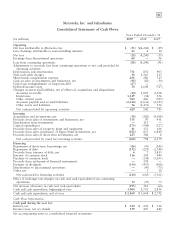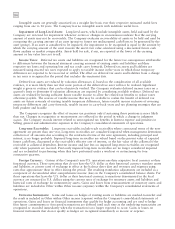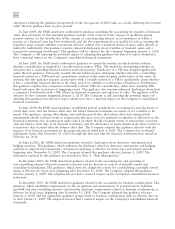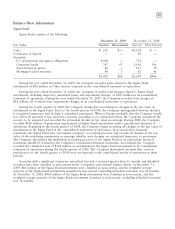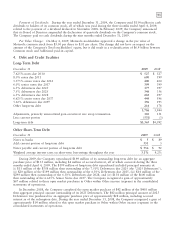Motorola 2009 Annual Report Download - page 92
Download and view the complete annual report
Please find page 92 of the 2009 Motorola annual report below. You can navigate through the pages in the report by either clicking on the pages listed below, or by using the keyword search tool below to find specific information within the annual report.
84
Intangible assets are generally amortized on a straight line basis over their respective estimated useful lives
ranging from one to 14 years. The Company has no intangible assets with indefinite useful lives.
Impairment of Long-Lived Assets: Long-lived assets, which include intangible assets, held and used by the
Company are reviewed for impairment whenever events or changes in circumstances indicate that the carrying
amount of assets may not be recoverable. The Company evaluates recoverability of assets to be held and used by
comparing the carrying amount of an asset (group) to future net undiscounted cash flows to be generated by the
asset (group). If an asset is considered to be impaired, the impairment to be recognized is equal to the amount by
which the carrying amount of the asset exceeds the asset’s fair value calculated using a discounted future cash
flows analysis or market comparables. Assets held for sale, if any, are reported at the lower of the carrying
amount or fair value less cost to sell.
Income Taxes: Deferred tax assets and liabilities are recognized for the future tax consequences attributable
to differences between the financial statement carrying amounts of existing assets and liabilities and their
respective tax bases and operating loss and tax credit carry forwards. Deferred tax assets and liabilities are
measured using enacted tax rates expected to apply to taxable income in the years in which those temporary
differences are expected to be recovered or settled. The effect on deferred tax assets and liabilities from a change
in tax rates is recognized in the period that includes the enactment date.
Deferred tax assets are reduced by valuation allowances if, based on the consideration of all available
evidence, it is more likely than not that some portion of the deferred tax asset will not be realized. Significant
weight is given to evidence that can be objectively verified. The Company evaluates deferred income taxes on a
quarterly basis to determine if valuation allowances are required by considering available evidence. Deferred tax
assets are realized by having sufficient future taxable income to allow the related tax benefits to reduce taxes
otherwise payable. The sources of taxable income that may be available to realize the benefit of deferred tax
assets are future reversals of existing taxable temporary differences, future taxable income exclusive of reversing
temporary differences and carry-forwards, taxable income in carry-back years and tax planning strategies that are
both prudent and feasible.
The Company recognizes the effect of income tax positions only if sustaining those positions is more likely
than not. Changes in recognition or measurement are reflected in the period in which a change in judgment
occurs. The Company records interest related to unrecognized tax benefits in Interest expense and penalties in
Selling, general and administrative expenses in the Company’s consolidated statements of operations.
Long-term Receivables: Long-term receivables include trade receivables where contractual terms of the note
agreement are greater than one year. Long-term receivables are considered impaired when management determines
collection of all amounts due according to the contractual terms of the note agreement, including principal and
interest, is no longer probable. Impaired long-term receivables are valued based on the present value of expected
future cash flows, discounted at the receivable’s effective rate of interest, or the fair value of the collateral if the
receivable is collateral dependent. Interest income and late fees on impaired long-term receivables are recognized
only when payments are received. Previously impaired long-term receivables are no longer considered impaired
and are reclassified to performing when they have performed under a workout or restructuring for four
consecutive quarters.
Foreign Currency: Certain of the Company’s non-U.S. operations use their respective local currency as their
functional currency. Those operations that do not have the U.S. dollar as their functional currency translate assets
and liabilities at current rates of exchange in effect at the balance sheet date and revenues and expenses using
rates that approximate those in effect during the period. The resulting translation adjustments are included as a
component of Accumulated other comprehensive income (loss) in the Company’s consolidated balance sheets. For
those operations that have the U.S. dollar as their functional currency, transactions denominated in the local
currency are measured in U.S. dollars using the current rates of exchange for monetary assets and liabilities and
historical rates of exchange for nonmonetary assets. Gains and losses from remeasurement of monetary assets and
liabilities are included in Other within Other income (expense) within the Company’s consolidated statements of
operations.
Derivative Instruments: Gains and losses on hedges of existing assets or liabilities are marked-to-market and
the result is included in Other within Other income (expense) within the Company’s consolidated statements of
operations. Gains and losses on financial instruments that qualify for hedge accounting and are used to hedge
firm future commitments or forecasted transactions are deferred until such time as the underlying transactions are
recognized or recorded immediately when the transaction is no longer expected to occur. Gains or losses on
financial instruments that do not qualify as hedges are recognized immediately as income or expense.









